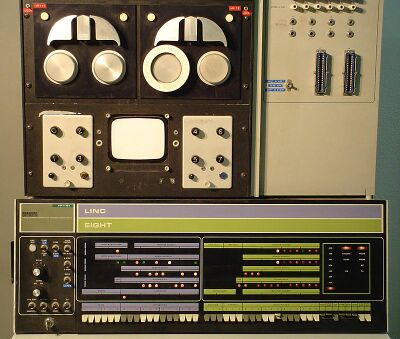Difference between revisions of "LINC-8"
m (+cats, +see also) |
(+image, links) |
||
| Line 1: | Line 1: | ||
| − | The '''LINC-8''' was a computer produced by [[DEC]] for use in laboratory settings; it included both a [[PDP-8]] and a [[LINC]] computer, which shared access to the PDP-8's memory (the LINC acted as a DMA peripheral to the PDP-8, using the PDP-8 data break mechanism). A combined | + | The '''LINC-8''' was a computer produced by [[Digital Equipment Corporation|DEC]] for use in laboratory settings; it included both a [[PDP-8]] and a [[LINC]] computer, which shared access to the PDP-8's [[main memory]] (the LINC acted as a [[Direct Memory Access|DMA]] peripheral to the PDP-8, using the PDP-8 [[data break]] mechanism). A combined [[front panel]] allowed control of both [[Central Processing Unit|CPU]]s. |
| − | Like the LINC, it included a video display (512x512 pixels), analog inputs, and [[LINC tape]] drives (all attached to the LINC); it could also include any of the standard PDP-8 | + | Like the LINC, it included a video [[display]] (512x512 pixels [[resolution]], but not a [[bit-mapped display]]), analog inputs, and [[LINC tape]] drives (all attached to the LINC); it could also include any of the standard PDP-8 [[peripheral]]s (attached to the PDP-8). |
| − | Special interrupt- | + | Special [[interrupt]]-driven code ('PROGOFOP' - 'program of operation') in the PDP-8 allowed code running in the LINC access to PDP-8 resources; the PDP-8 likewise had access to the resources of the LINC (e.g. the display). When the PDP-8 was in control, the LINC was halted until the PDP-8 wanted something done, whereupon an interrupt started the LINC running, to perform the desired action. |
| + | |||
| + | ==Images== | ||
| + | |||
| + | [[Image:LINC-8 RCS'RI.jpg|400px|LINC-8 at the Retro-Computing Society of Rhode Island]] | ||
==See also== | ==See also== | ||
Revision as of 14:28, 9 January 2021
The LINC-8 was a computer produced by DEC for use in laboratory settings; it included both a PDP-8 and a LINC computer, which shared access to the PDP-8's main memory (the LINC acted as a DMA peripheral to the PDP-8, using the PDP-8 data break mechanism). A combined front panel allowed control of both CPUs.
Like the LINC, it included a video display (512x512 pixels resolution, but not a bit-mapped display), analog inputs, and LINC tape drives (all attached to the LINC); it could also include any of the standard PDP-8 peripherals (attached to the PDP-8).
Special interrupt-driven code ('PROGOFOP' - 'program of operation') in the PDP-8 allowed code running in the LINC access to PDP-8 resources; the PDP-8 likewise had access to the resources of the LINC (e.g. the display). When the PDP-8 was in control, the LINC was halted until the PDP-8 wanted something done, whereupon an interrupt started the LINC running, to perform the desired action.
Images
See also
Further reading
Detailed information is given in:
- "Small Computer Handbook", 1967 edition
